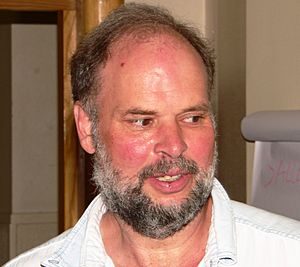Vaughan Jones facts for kids
Quick facts for kids
Sir
Vaughan Jones
|
|
|---|---|

Jones in 2007
|
|
| Born |
Vaughan Frederick Randal Jones
31 December 1952 Gisborne, New Zealand
|
| Died | 6 September 2020 (aged 67) |
| Nationality | New Zealander |
| Alma mater | University of Geneva University of Auckland |
| Known for | Jones polynomial Aharonov–Jones–Landau algorithm |
| Spouse(s) | Martha Myers |
| Awards | Fields Medal (1990) |
| Scientific career | |
| Fields | Von Neumann algebras, knot polynomials, conformal field theory |
| Institutions | University of California, Berkeley Vanderbilt University University of California, Los Angeles University of Pennsylvania |
| Doctoral advisor | André Haefliger |
Sir Vaughan Frederick Randal Jones (born 31 December 1952 – died 6 September 2020) was a famous mathematician from New Zealand. He was best known for his amazing work on knot polynomials. These are special mathematical tools used to study knots. He also worked on von Neumann algebras, which are a complex part of mathematics. In 1990, he received the Fields Medal, one of the highest awards a mathematician can get.
Contents
Early Life and Education
Vaughan Jones was born in Gisborne, New Zealand, on 31 December 1952. He grew up in Cambridge, New Zealand. He went to St Peter's School there.
Later, he won a special scholarship called the Gillies Scholarship. This allowed him to attend Auckland Grammar School, where he finished in 1969. He then studied at the University of Auckland. He earned his first degree, a Bachelor of Science (BSc), in 1972. The next year, in 1973, he got his Master of Science (MSc) degree.
For his advanced studies, Vaughan moved to Switzerland. He completed his PhD, which is a very high university degree, at the University of Geneva in 1979. His main teacher there was André Haefliger. Vaughan's work earned him the Vacheron Constantin Prize.
Discoveries and Career
In 1980, Vaughan Jones moved to the United States. He taught mathematics at the University of California, Los Angeles for a year. Then he taught at the University of Pennsylvania until 1985. After that, he became a professor of mathematics at the University of California, Berkeley.
It was at Berkeley that he made his most famous discovery: the Jones polynomial. This was a new way to understand and classify knots using mathematics. It was a big surprise because it came from a different area of math called von Neumann algebras. This discovery helped solve many old problems in knot theory. It also led to new interest in low-dimensional topology, which is the study of shapes in 3D or 4D spaces. It even helped create a new field called quantum topology.
From 2011 until he passed away, Jones taught at Vanderbilt University. He was also a Professor Emeritus at the University of California, Berkeley. This means he was a retired professor who still kept his title. He was also a special professor at the University of Auckland, his old university.
In 1992, Vaughan Jones was made an honorary vice-president for life of the International Guild of Knot Tyers. This group studies and practices knot tying. In 2010, the Royal Society of New Zealand created a special award called the Jones Medal, named after him.
Personal Life
Vaughan Jones met his wife, Martha Myers, while they were both studying in Switzerland. They met at a ski camp for students from other countries. Martha was a Fulbright scholar, which is a special scholarship for students to study abroad. She later became a professor who taught about medicine and society. Vaughan and Martha had three children together.
Vaughan Jones passed away on 6 September 2020. He was 67 years old. He died due to health problems from a serious ear infection.
Awards and Recognitions
Vaughan Jones received many important awards and honours for his work:
- 1990 – He was given the Fields Medal. This is like the Nobel Prize for mathematics.
- 1990 – He became a Fellow of the Royal Society. This is a very old and respected group of scientists in the UK.
- 1991 – He received the Rutherford Medal from the Royal Society of New Zealand.
- 1991 – The University of Auckland gave him an honorary degree, a Doctor of Science.
- 1992 – He was chosen to be a Corresponding Fellow of the Australian Academy of Science.
- 2002 – He was made a Distinguished Companion of the New Zealand Order of Merit. This is a high honour from New Zealand for his services to mathematics.
- 2009 – His honour was changed to a Knight Companion of the New Zealand Order of Merit. This meant he could use the title "Sir."
- 2012 – He was chosen as a Fellow of the American Mathematical Society.
See also
 In Spanish: Vaughan Jones para niños
In Spanish: Vaughan Jones para niños
- Aharonov–Jones–Landau algorithm
- Planar algebra
- Subfactor

